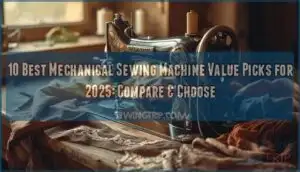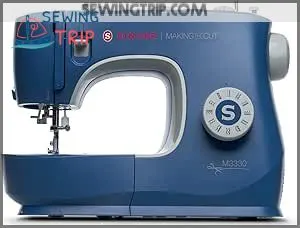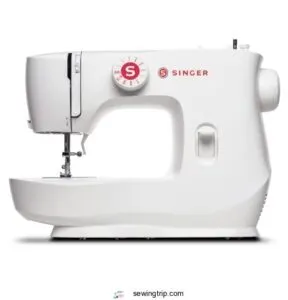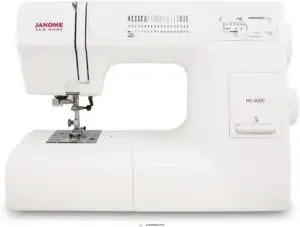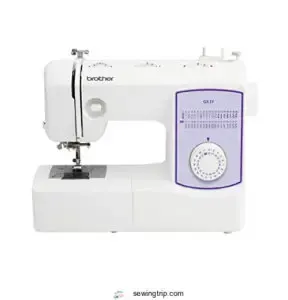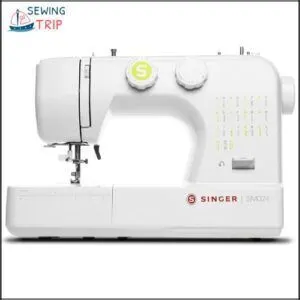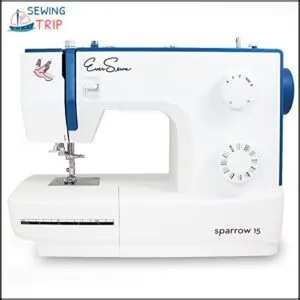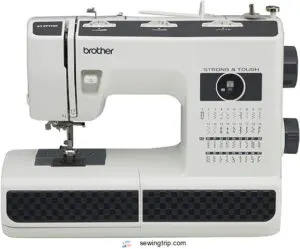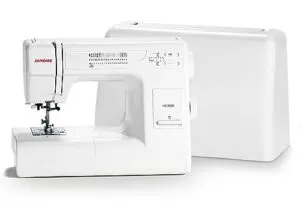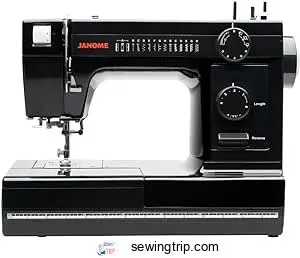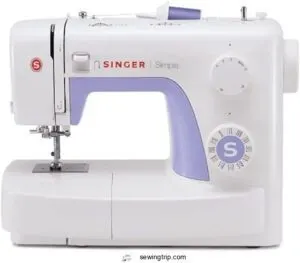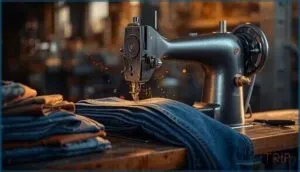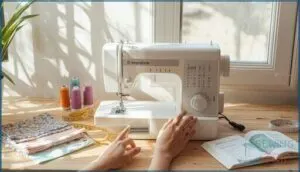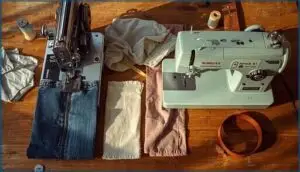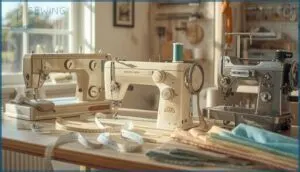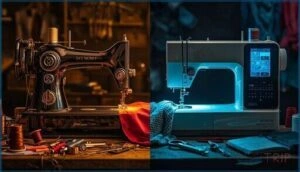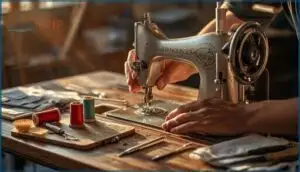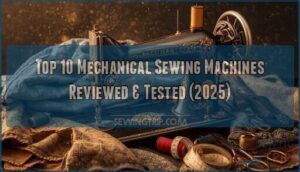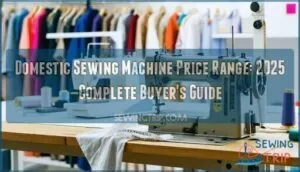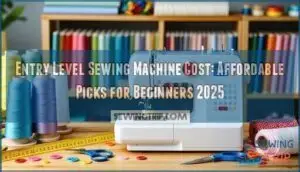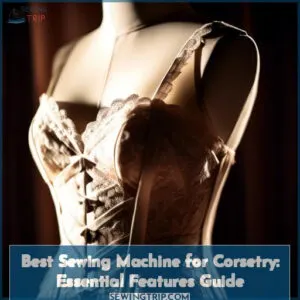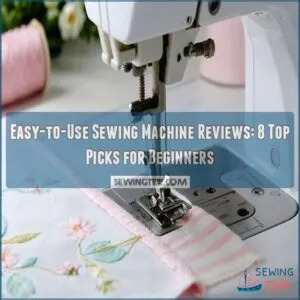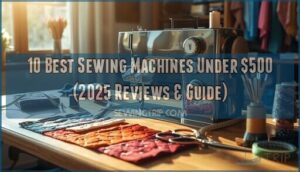This site is supported by our readers. We may earn a commission, at no cost to you, if you purchase through links.
A mechanical sewing machine that lasts 20 years costs you about $75 per year to maintain. Compare that to replacing a computerized model every 5-7 years, and the math gets interesting fast.
But longevity isn’t the only factor that determines value—you need the right balance of features, durability, and price for your specific projects. Some machines handle denim like butter but struggle with delicate fabrics. Others offer 50 stitch patterns you’ll never use while skipping the essentials you need daily.
The best mechanical sewing machine value isn’t about finding the cheapest option or the one with the most features—it’s about matching capabilities to your actual sewing needs without paying for bells and whistles that sit unused.
Table Of Contents
- Key Takeaways
- Key Features of Mechanical Sewing Machines
- Factors That Define Sewing Machine Value
- Top 10 Best Mechanical Sewing Machines
- 1. Singer Easy Sewing Machine Kit
- 2. Portable Singer Sewing Machine Kit
- 3. Janome Heavy Duty Sewing Machine
- 4. Brother GX37 Beginner Sewing Machine
- 5. Singer Sewing Machine For Beginners
- 6. Easy Mechanical Sewing Machine Sparrow
- 7. Brother ST371HD Heavy Duty Sewing Machine
- 8. Janome HD3000 Heavy Duty Sewing Machine
- 9. Janome HD1000BE Black Edition Machine
- 10. Singer Simple Sewing Machine
- Comparing Heavy-Duty and Beginner Models
- Choosing The Right Mechanical Sewing Machine
- Mechanical Vs Computerized Sewing Machines
- Tips for Maximizing Sewing Machine Value
- Frequently Asked Questions (FAQs)
- Conclusion
Key Takeaways
- Mechanical sewing machines deliver superior long-term value with 20+ year lifespans and roughly $1,300 total ownership costs over 15 years, compared to $3,000 for computerized models that need replacement every 5-7 years.
- The best value comes from matching machine capabilities to your actual projects—heavy-duty models with metal frames handle thick fabrics like denim and canvas, while beginner machines with 10-30 built-in stitches cover everyday sewing without unnecessary features.
- Mechanical machines offer 73% on-site repair success rates and 35% lower maintenance costs over five years because their manual controls and simple construction make parts easy to access and replace with basic tools.
- Regular maintenance—oiling every 8-10 hours of use, monthly lint removal, and annual professional servicing ($30-$65)—extends machine life to 20 years and prevents costly breakdowns.
Key Features of Mechanical Sewing Machines
If you’re considering a mechanical sewing machine, you’ll want to know what sets these models apart.
The main features shape how you sew, maintain, and get creative with your projects.
Let’s look at what matters most when choosing your machine.
Manual Controls Vs Computerized Options
When you compare manual controls on mechanical sewing machines to computerized options, you’re really weighing control precision against automation benefits. Here’s what matters most:
- Manual sewing machine: direct, tactile control
- Computerized sewing machines: automation and memory functions
- Machine reliability: fewer failure points in mechanical models
- Skill adaptability: beginners master manual controls faster
Cost evaluation always favors simplicity. Mechanical machines are ideal for those who value hands-on experience.
Built-in Stitch Patterns and Variations
Once you’ve mastered manual controls, stitch functionality becomes your playground. Mechanical machines generally offer 10–30 built-in stitch patterns—straight, zigzag, buttonhole, and more.
Pattern selection is handled by dials, giving you tactile control over stitch mechanics. Adjustability range lets you tweak length and width for each stitch type, directly influencing versatility and project outcomes.
Stitch options matter; for instance, some machines include decorative scallop stitches for adding unique embellishments.
Durability and Maintenance Benefits
A mechanical sewing machine with a metal frame is built to last—think 25 years or more with routine care. Durable construction shrugs off daily use and rougher operating conditions. Easy maintenance keeps repair costs low, and part accessibility means you won’t wait weeks for fixes.
Lifespan optimization is simple: regular cleaning and oiling go a long way toward reliable, heavy-duty performance.
Essential Convenience Features (needle Threader, Presser Feet, Etc.)
Strong frames mean less downtime, but what keeps your sewing smooth day-to-day? Convenience features matter. Needle threaders save time and headaches. Swappable presser feet handle every fabric. Storage solutions keep sewing machine accessories close at hand. Feed control and fabric handling help with tricky seams. These features put you in control—making sewing easier and more enjoyable.
- Needle Threaders
- Presser Feet
- Storage Solutions
- Feed Control
- Fabric Handling
Factors That Define Sewing Machine Value
When you’re shopping for a mechanical sewing machine, a few core factors make all the difference in value. It’s not just about price—it’s about how well the machine fits your needs and stands up over time.
Let’s look at what really matters before you choose.
Price-to-performance Ratio
Ever wondered how far your dollar stretches in sewing? The best value sewing machine balances Initial Investment with Performance Stability, reliable features, and Brand Reputation.
Affordable sewing machines in the $120–$200 range deliver a strong Price-to-performance Ratio.
Feature Prioritization matters—needle threaders and bobbin systems add real Value Over Time, letting you focus on your craft, not your budget.
Build Quality and Longevity
Frame materials and internal components make all the difference. A heavy-duty metal frame means sturdy construction and real durability—machines like Janome HD-series last decades with proper care. Design advancements, like reinforced gears and better lubrication, boost lifespan and reliability.
Regular maintenance impacts performance, keeping your investment running smoothly. Compare lifespans: mechanical units outlast computerized models by years.
Versatility for Different Sewing Projects
If you want a machine that keeps up with your creativity, versatility is key. Mechanical Sewing Machines handle everything from light cotton to heavy canvas, thanks to durable fabric compatibility and adjustable stitch styles.
Their accessory potential—like snap-on feet and extension tables—means you can tackle a wide range of sewing projects, adapting easily as your skill levels grow.
Ease of Use for Beginners and Experts
Ever notice how a truly user-friendly sewing machine feels like second nature? Mechanical models shine with straightforward controls and ergonomic design, making the learning curve shorter for beginners.
Easy-to-use features—like drop-in bobbins and adjustable presser feet—help you progress your skills. Maintenance simplicity means less downtime, so both beginners and experts can focus on sewing, not troubleshooting.
Top 10 Best Mechanical Sewing Machines
Choosing the right mechanical sewing machine can make all the difference in your projects. Here are ten models that stand out for reliability, features, and value.
Take a look to see which one matches your needs best.
1. Singer Easy Sewing Machine Kit
Ever tried sewing with a kit that feels ready for anything? The Singer Easy Sewing Machine Kit stands out for its Metal Frame, 32 Stitch Patterns, and reliable Needle Threader—ideal for Budget-minded beginners.
Kit Accessories cover every base, from needles to presser feet, making it a solid pick among Budgetfriendly sewing machines. Beginner Usability is front and center, so you won’t feel lost.
If you’re after mechanical sewing machines that balance value and durability, Singer Making the Cut delivers.
Best For: Beginners and casual home sewers who want an easy-to-use, versatile machine with plenty of accessories at a budget-friendly price.
- Durable metal frame and stable construction for long-lasting use.
- Includes a 130-piece accessory kit, so you’re ready to start any project.
- Simple stitch selection and automatic needle threader make setup easy for newcomers.
- Some users find the front-loading bobbin tricky and prone to jams.
- No written instructions included, which can make first-time setup confusing.
- The auto threader can be delicate and may require careful handling.
2. Portable Singer Sewing Machine Kit
Looking for a portable sewing machine that won’t weigh you down? The Singer Portable Sewing Machine Kit is light as a feather—perfect for sewing classes or tight spaces. Portability benefits shine with a compact frame, while kit contents include presser feet and bobbins for basic projects.
Stitch capabilities cover 32 applications, ideal for hemming and light embroidery. Pricing analysis shows models start under $160, making them a smart budget choice. Maintenance needs are low, so you’ll spend more time sewing and less time troubleshooting.
Best For: Beginners, hobbyists, or anyone needing a lightweight sewing machine for small projects and easy transport.
- Compact and easy to carry, great for classes or small spaces.
- Simple to use with 32 stitch applications and preset settings.
- Affordable price point with included essential accessories.
- Struggles with thick fabrics or heavy-duty projects.
- No automatic needle threader or carrying case included.
- Some users report occasional jamming or flimsy pedal and cord.
3. Janome Heavy Duty Sewing Machine
If portability is your priority, but you need real muscle, the Janome HD3000 stands tall among heavy-duty sewing machines. Its die-cast aluminum frame means HD3000 durability you can trust, even on layered denim or canvas.
Stitch quality stays sharp thanks to a seven-piece feed dog system and reliable motor performance. Accessory value is high—eight presser feet, a hard cover, and handy guides.
Market comparison shows it outlasts the Janome HD1000 HeavyDuty, making it one of the best mechanical sewing machines for serious home use.
Best For: Home sewers who need a tough, reliable machine for everyday projects, thick fabrics, and occasional heavy-duty work.
- Solid die-cast aluminum body keeps vibration low and durability high.
- Handles denim, canvas, and layered fabrics with ease.
- Comes with eight presser feet and a hard cover for great accessory value.
- Limited harp space makes it tricky for large quilting projects.
- No automatic thread cutter or knee lift.
- Buttonhole setting requires three steps, which can slow you down.
4. Brother GX37 Beginner Sewing Machine
Switching gears from heavy-duty workhorses, the Brother GX37 stands out as a sewing machine for beginners who want user-friendliness without sacrificing stitch functionality. Its design quality—compact, sturdy, with a free arm and metal frame—makes it easy to handle.
You get 37 built-in stitches, automatic needle threading, and six presser feet, all at a budget price. Market reception backs its performance reliability, especially for everyday sewing. If you value mechanical sewing machines with practical features, this one’s hard to beat.
Best For: Beginners and casual sewists who want an easy-to-use, versatile machine for everyday sewing and quilting projects.
- Wide range of built-in stitches and included accessories for versatility.
- Automatic needle threader and drop-in bobbin make setup fast and simple.
- Compact, portable design with quiet operation suits small spaces.
- Not suitable for heavy-duty fabrics or commercial use.
- LED light may be too dim for detailed work.
- Built-in storage compartment can be tricky to access.
5. Singer Sewing Machine For Beginners
Next up, the Singer Sewing Machine For Beginners is a solid pick for anyone mastering Sewing Basics. You’ll find Machine Setup straightforward, with an automatic needle threader and clear stitch dials. Thread Management is smooth thanks to the easy-winding bobbin and LED-lit workspace.
For Beginner Sewists, this model manages everything from simple repairs to first-time Fabric Selection. It’s built with a durable metal frame, so you get steady performance for years. Start with Beginner Projects—like zipper pouches—and build confidence quickly.
Best For: Beginners and hobbyists looking for an easy-to-use, reliable sewing machine for basic projects and repairs.
- Simple setup with automatic needle threader and clear dials.
- Durable metal frame reduces vibration and ensures steady stitching.
- LED lighting and easy bobbin winding make sewing more comfortable.
- Occasional issues with the pedal and thread jams.
- Limited capability for heavy fabrics like denim or canvas.
- Warranty validation can be tricky to process online.
6. Easy Mechanical Sewing Machine Sparrow
If you’re after user-friendly sewing machines, the EverSewn Sparrow 15 stands out for beginners and seasoned sewers alike. Its Sparrow Features—like the automatic needle threader, side thread cutter, and adjustable Sewing Speed—make Thread Control easy. The compact Machine Portability lets you bring it to classes or retreats without hassle.
The User Interface is simple: manual dials, clear stitch selection, and a bright LED workspace. Mechanical Sewing Machines like this one earn high marks in Sewing machine reviews and comparisons for reliability.
Best For: Beginners, kids, and home sewers who want a simple, portable machine for everyday sewing and small quilting projects.
- Easy to set up and use, with intuitive manual controls and automatic needle threader.
- Lightweight and compact, making it great for travel or small spaces.
- Durable metal frame and reliable stitch quality for long-term use.
- Can be noisy or make clunking sounds during operation.
- Limited throat depth makes large quilting projects tricky.
- May skip stitches or freeze up occasionally, especially with thicker fabrics.
7. Brother ST371HD Heavy Duty Sewing Machine
Reliability shines with the Brother ST371HD Heavy Duty Sewing Machine. Mechanical Stitch Control lets you fine-tune your work, whether you’re tackling denim or delicate silk. Heavy Duty Features like a metal needle plate and spring-action zigzag foot boost Fabric Compatibility for all sorts of projects.
User Experience Reviews highlight its jam-resistant bobbin and automatic needle threader—making setup a breeze for beginner sewers. In any Sewing Machine Comparison, the ST371HD stands out among Mechanical Sewing Machines for value and performance.
Best For: Beginners and intermediate sewers who want a reliable machine for both everyday projects and heavy-duty fabrics.
- Handles thick materials like denim and canvas with ease.
- Easy setup thanks to automatic needle threader and drop-in bobbin.
- Offers 37 built-in stitches for creative flexibility.
- Some users find threading the machine tricky at first.
- Pedal may emit a plastic smell during use.
- Not suitable for sewing nylon materials.
8. Janome HD3000 Heavy Duty Sewing Machine
Muscle meets finesse with the Janome HD3000 Heavy Duty Sewing Machine. Its Mechanical Performance shines when tackling layers of denim or silk, thanks to its sturdy aluminum body and 18 built-in stitches.
Sewing Machine Durability is a highlight, with minimal maintenance needed even after years of use. User Experience reviews praise its built-in needle threader and extra presser feet.
If you value Fabric Compatibility and reliability, this HeavyDuty mechanical sewing machine deserves a spot on any beginner or expert’s shortlist.
Best For: Beginners and experienced sewists who need a durable, easy-to-use machine for heavy fabrics and everyday sewing projects.
- Handles thick and delicate fabrics without trouble
- Built-in needle threader and extra presser feet make setup easy
- Durable metal frame with minimal maintenance required
- Limited number of stitches compared to computerized models
- No adjustable speed control; relies on foot pedal only
- Foot pedal cord may be too short for some setups
9. Janome HD1000BE Black Edition Machine
Stability and strength distinguish the Janome HD1000BE Black Edition within heavy-duty mechanical sewing machines. With an industrial-grade aluminum frame, 14 built-in stitches, and a sewing speed of up to 840 stitches per minute, this model offers powerful Janome features for both novice and experienced crafters.
Mechanical components ensure lower maintenance, while the extra-high presser foot lift enhances versatility. Sewing machine reviews frequently praise its quiet operation and dependable performance for daily projects.
Best For: Home sewers and crafters who want a reliable, sturdy machine for everyday sewing and light leather work.
- Durable all-metal frame with a 25-year warranty
- Quiet operation and easy-to-use manual controls
- Includes specialty accessories for leather and layered fabrics
- Not suitable for thick materials like Cordura or heavy denim
- Some users report issues with self-threading and bobbin jams
- May arrive with greasy residue or sharp plastic edges
10. Singer Simple Sewing Machine
Ever wondered why the Singer Simple 3232 keeps popping up in sewing machine reviews? For those mastering Sewing Basics, this Singer Machine brings 110 stitch applications, a built-in needle threader, and smooth Thread Management. Its heavy-duty frame manages Fabric Handling with ease, making it a top pick among Best mechanical sewing machines for beginners.
Mechanical Sewing Machines like this shine in daily use—easy Maintenance Tips, portable design, and reliable performance. If you’re after a Beginner sewing machine, it’s hard to beat.
Best For: Beginners and casual sewists looking for a reliable, easy-to-use machine for everyday projects.
- Simple to set up and operate, even for first-time users.
- Sturdy metal frame handles thick fabrics and multiple layers.
- Lightweight and portable for easy storage or travel.
- May sew faster than some beginners prefer, requiring practice.
- Tension settings can be finicky with certain threads.
- Power cord and pedal may not work outside the US without an adapter.
Comparing Heavy-Duty and Beginner Models
Choosing between heavy-duty and beginner sewing machines comes down to more than just price or looks. Each type brings its own strengths, whether you’re handling thick denim or just starting out with simple projects.
Here’s how the main features and differences stack up.
Heavy-duty Features for Tough Fabrics
If you’re working with heavy fabrics, you’ll want a heavyduty mechanical sewing machine built for real power. Heavy Duty Motors and High Torque Capacity drive consistent Fabric Penetration, even through layers of denim or canvas.
Metal Frame Construction and a heavyduty metal frame keep vibrations low, while adjustable presser foot pressure ensures reliable Stitch Reinforcement on every pass.
Best Options for New Sewers
Choosing your first mechanical sewing machine can feel like picking a trusty sidekick. For beginner sewists, models like the Singer Start 1304 or Brother GX37 keep Sewing Basics simple, with easy dials and clear guides.
These beginner sewing machines balance affordability and reliability—perfect for building skills, joining the Sewing Community, and exploring Learning Resources without feeling overwhelmed by features.
Stitch Range and Speed Differences
If you’re comparing heavy-duty and beginner machines, pay close attention to Stitch Range and Speed Settings. Heavy-duty models offer wider Stitch Length and Stitch width for tough fabrics, while beginner machines stick to basic Stitch options and styles.
Thread Tension control and Sewing Efficiency differ too, influencing how well each model manages Stitch applications and Fabric Compatibility.
Maintenance and Reliability Considerations
Speed and stitch range matter, but Machine Longevity and Repair Costs often tip the scales. Heavy-duty models shine in Part Durability, handling frequent use with fewer breakdowns.
User Maintenance is straightforward—regular cleaning and oiling keep things running smoothly. Service Intervals for both types are similar, but heavy-duty machines offer greater durability and reliability, reducing overall sewing machine maintenance and troubleshooting sewing machines.
Choosing The Right Mechanical Sewing Machine
Finding the right mechanical sewing machine starts with knowing what you need and how you plan to use it. There are a few key factors that can help you narrow down your choices.
Let’s look at what matters most when picking the best fit for your sewing style.
Assessing Your Sewing Needs and Skill Level
How do you match your sewing skill assessment to the right mechanical sewing machine? Start by considering your comfort with machine operation and project planning. Beginners benefit from straightforward sewing machine features, while experienced users may need models suited for a wider range of fabric selection and stitch selection.
Think about the types of sewing projects you’ll tackle before making a choice.
Evaluating Stitch Options and Accessories
Now that you’ve sized up your skill level, it’s time to weigh Stitch Variety and Accessory Kits. Look for:
- Stitch patterns—straight, zigzag, and decorative for flexibility.
- Thread Management features, like easy bobbin types and builtin stitches.
- Sewing machine accessories—presser feet, seam rippers, and needles—boost your options.
Practical choices here help you master any project.
Portability and Storage Considerations
When space is tight, Compact Designs and Lightweight Models make all the difference. Portable Machines slip easily onto shelves or into cabinets, while a storage tray keeps accessories in check.
For flexible projects, an extrawide extension table adds workspace but stows away fast. Space Optimization means you won’t sacrifice manual control, even when working with lightweight fabrics.
Warranty and After-sales Support
When you’re choosing a mechanical sewing machine, pay close attention to warranty duration and the service network. Industry standards vary, but brands like Singer and Janome offer up to 25 years on the head.
Understand the claim process and exclusions covered. Reliable technical support helps with troubleshooting, maintenance, and repairs, so you won’t be left weaving through problems alone.
Mechanical Vs Computerized Sewing Machines
Choosing between mechanical and computerized sewing machines comes down to what matters most to you. Each type has its strengths and trade-offs that can shape your sewing experience.
Let’s break down the key differences so you can see which fits your style best.
Pros and Cons of Mechanical Designs
Ever wanted full control at your fingertips? Mechanical sewing machines put you in the driver’s seat with manual controls and tactile feedback. You’ll notice repair simplicity and energy efficiency, but there’s a learning curve and speed limitations to keep in mind. Here’s a quick breakdown:
| Pros | Cons |
|---|---|
| Manual Control | Learning Curve |
| Repair Simplicity | Speed Limitations |
| Energy Efficiency | Limited Features |
Cost Differences and Long-term Value
Your wallet will thank you—mechanical machines cost 30% less upfront, averaging $100–$500 versus $300–$3,000 for computerized models. But the real savings show up over time. Mechanical units deliver excellent long-term value through lower repair expenses ($75 annually versus $100), longer lifespans (20+ years versus 10–15), and better depreciation rates (10–15% yearly versus 20–25%). Total ownership costs over 15 years? Roughly $1,300 for mechanical, $3,000 for computerized. That’s budget-friendly durability and build quality you can count on.
| Cost Factor | Mechanical | Computerized |
|---|---|---|
| Upfront Cost | $100–$500 | $300–$3,000+ |
| Annual Maintenance | $75 average | $100 average |
| 15-Year Ownership | ~$1,300 total | ~$3,000 total |
| Lifespan Analysis | 20+ years | 10–15 years |
Affordable sewing machines don’t mean sacrificing the best value sewing machine performance. Easy maintenance and solid build keep ownership costs low, making mechanical models the clear winner for durability and lasting returns.
User Control and Repairability
Manual precision gives you hands-on control—dials and levers adjust stitch length, width, and tension without digital interference. That’s where repair simplicity shines: Repair Café data show 73% of mechanical machines are fixed on-site, while manual operation means easy component access. Replace gears, pedals, or bobbin cases in under 30 minutes with basic tools. Longevity factors? 20+ year lifespans and minimal electronic failures. Economic advantages are clear—maintenance costs run 35% lower over five years compared to computerized models.
| Feature | Mechanical Advantage |
|---|---|
| Manual Thread Tension Control | Direct dial adjustment, no calibration software |
| Repair Success Rate | 73% fixed by community technicians |
| Component Replacement Time | Under 30 minutes with hand tools |
Tips for Maximizing Sewing Machine Value
Getting the most out of your mechanical sewing machine isn’t just about picking the right model—it’s about how you use and maintain it. Simple habits can extend its lifespan by years and reveal capabilities you didn’t know it had.
Here’s how to squeeze every bit of value from your investment.
Proper Care and Regular Maintenance
Your machine won’t last without proper care—think of maintenance as the insurance policy for years of reliable stitching. Annual professional servicing, costing around $30 to $65, keeps your machine humming and catches problems before they snowball.
Daily users benefit from biannual check-ups, while occasional sewers can stick to yearly visits. Easy maintenance habits—like unplugging before cleaning and using quality thread—cut lint buildup and extend machine life to 10–20 years.
- Lint removal from bobbin area and throat plate monthly prevents jamming
- Oiling procedures every 8–10 hours of use reduce friction and wear
- Needle replacement after each project or 8 hours stops skipped stitches
- Storage tips: cover your machine and avoid humid, dusty environments
- Technician role: certified pros handle internal adjustments DIY cleaning can’t reach
Accessorizing for Expanded Functionality
The right accessories turn your machine into a multi-tool. Presser feet tackle specialty tasks—walking feet cut fabric drag by 35% on long seams, while Teflon versions glide over vinyl and leather.
Extension tables expand your workspace by up to 40%, slashing fatigue and distortion on quilts. Embroidery kits, thread management tools like multi-spool stands, and accessory packs (usually 10–20 items for $60–$120) boost functionality without replacing your machine—78% of users prefer upgrading accessories over buying new.
Best Beginner Projects to Get Started
Once accessories boost your setup, put them to work. Pillow covers let you practice straight stitches in under 30 minutes—perfect for beginner sewists testing their new sewing machine. Tote bags appear in 60% of beginner sewing projects because they teach flat seams without complex fitting.
For quick wins with your best mechanical sewing machines, try scrunchies (15 minutes), fabric coasters (10 minutes), or zipper pouches—simple sewing that builds confidence fast.
Experts say completing 3–5 fabric crafts in your first month raises your odds of sticking with sewing basics by 40%.
Frequently Asked Questions (FAQs)
What are the different types of sewing machines?
You’ll encounter four main sewing machine types. Mechanical models use manual dials and knobs—perfect for basic sewing techniques and fabric handling.
Computerized sewing machines offer automated features and extensive stitch libraries.
Sergers finish edges on knits and stretchy materials.
Embroidery machines add decorative designs to garments and accessories.
What is the best mechanical sewing machine?
There’s no single “best” mechanical sewing machine—it’s like asking if a telegraph beats email for every job. Your ideal beginner sewing machine depends on fabric compatibility, thread management needs, and whether you’re chasing heavyduty sewing machines for denim or lightweight models for quilting.
Sewing machine reviews show Janome HD3000 and Brother GX37 lead on mechanical stitch quality, sewing speed control, and best value sewing machine features.
How to choose a mechanical sewing machine?
Start by evaluating your sewing needs and skill level. Beginners should prioritize ease of use and basic sewing machine features, while experienced users might need more stitch options.
Check user reviews and comparison guides to match budget planning with machine selection for the best mechanical sewing machine.
How much does a sewing machine cost?
Basic mechanical sewing machines start around $200, while heavy-duty models reach $1,500. Computerized options cost slightly more but share similar entry prices.
Long-term ownership costs—maintenance, repairs, accessories—add $150–$250 annually, making budget-friendly mechanical machines affordable for beginners.
How often should I oil my machine?
Oil your mechanical sewing machine every 8–10 hours of active use. For daily sewing, that means weekly maintenance. Occasional users should oil monthly or after major projects.
Check for noise or sluggish performance—these inspection signs tell you it’s time.
Can mechanical machines handle thick upholstery fabric?
Heavy-duty mechanical sewing machines can handle thick upholstery fabric with motors of 0-5 amps or higher. Look for metal frames and walking foot benefits.
For denim and canvas projects, use heavy-duty needles (100/16 to 110/18) with bonded nylon thread.
Whats the average lifespan of these machines?
Most mechanical sewing machines last 10 to 20 years with proper care. Usage impact and maintenance matters most—regular oiling and cleaning extend durability.
Build quality, especially durable metal frames, boosts longevity beyond plastic models, reducing repair costs.
Are replacement parts easy to find locally?
Finding parts is like hunting treasure—sometimes it’s right in your local shop, sometimes you need a map to online sources. Basic universal parts like needles and bobbins are easy to find locally, but model age and brand parts matter.
Vintage availability varies, and complex mechanical sewing machine repairs often require online sources for specific components.
Do mechanical machines work well for quilting projects?
Yes, mechanical sewing machines work well for quilting projects. Models like the Janome HD3000 and Juki TL-2010Q offer excellent fabric handling, stitch precision, and durability.
They’re affordable sewing machines that provide tactile control for free-motion quilting and handle various project sizes.
Your skill level and stitch options matter most when selecting the right machine for weaving through sewing projects.
Conclusion
You might think mechanical machines can’t handle modern projects—but that’s exactly backward. The best mechanical sewing machine value comes from matching durability to your actual workload, not chasing features you’ll ignore.
Heavy-duty models power through denim and canvas for decades. Beginner-friendly options deliver reliable straight stitches without complexity. Your choice hinges on fabric weight, stitch variety, and how long you plan to keep it running.
Pick based on what you’ll sew tomorrow, not what sounds impressive today. The right machine pays for itself in longevity.
- https://www.bsewinn.com/blogs/inspiration/computerized-sewing-machines-vs-mechanical
- https://www.sewingmachineshop.net/rates-repairs/
- https://www.sewingmachinesinstitute.com/single-post/sewing-machine-life-expectancy
- https://stitchingelite.com/best-sewing-machines/
- https://www.reddit.com/r/SewingForBeginners/comments/1jfkb3h/computerized_vs_mechanical_for_a_beginner_which/

